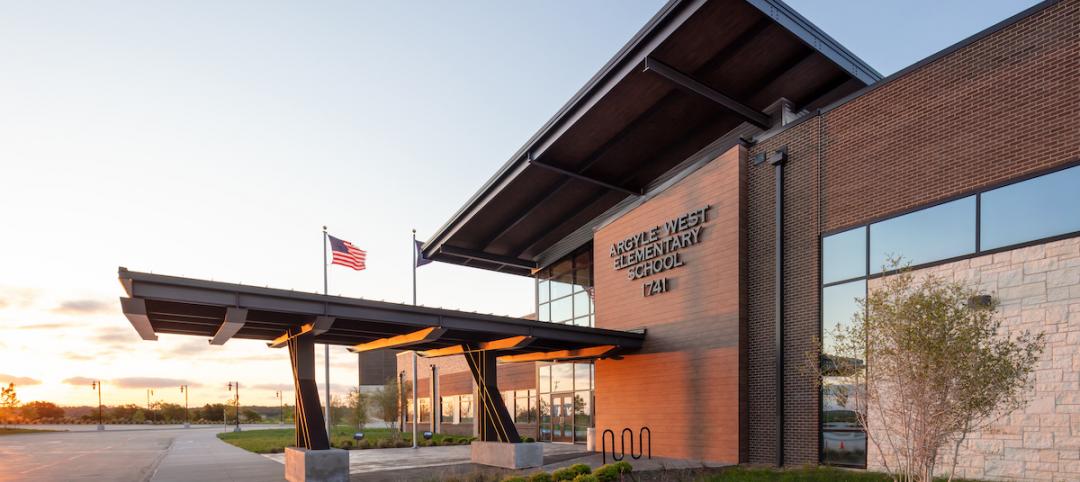 |
| The Haverford School campus was active during construction, so the soccer team had to practice within 10 feet of where the Upper School’s site fencing had been erected. |
Imagine this scenario: You're planning a $32.9 million project involving 112,000 sf of new construction and renovation work, and your job site is an active 32-acre junior-K-to-12 school campus bordered by well-heeled neighbors who are extremely concerned about construction noise and traffic.
Add to that the fact that within 30 days of groundbreaking, the general contractor gets canned. And one more thing: you have 15 months until the school bell rings.
This nightmare situation is exactly what Mike Rufo faced as construction manager for The Haverford School, a private school for 981 boys, on Philadelphia's Main Line. Rufo, owner of Rufo Contracting Inc. of Conshohocken, Pa., had worked with the school since 1992, when the institution launched a 15-year program to upgrade its campus. The project in question—construction of a new Upper School building and a new library totaling 87,000 sf and the renovation of Wilson Hall, the school's original 25,000-sf, 1903 classroom building—would be his last for the client, and one he would not forget.
 |
| The brick and glass Upper School (above) angles around to create a nook for the amphitheater. The 87,000 sf of new construction connects to the renovated Wilson Hall (below) to create the school’s new face. |
 |
In July 2007, with the original GC out, Rufo's most pressing concern was finding a qualified replacement—fast! Three firms looked at the project schedule and turned him down flat. With less than 400 days before the opening day, Rufo contracted with INTECH Construction of Philadelphia. The new GC took over a job site where demolition had started, the first foundations had been poured, the installation of sheeting, shoring, and soil nailing had begun, and steel was on order.
INTECH also inherited a project located in a residential neighborhood where on-site work was limited to the hours from 8 am to 6 pm, and never on Sunday. Deliveries could not be made using residential streets. Well-connected neighbors made sure these rules were enforced.
INTECH's first task was reassuring the remaining Building Team members—including a number of worried subcontractors and the equally nervous designer—that the project schedule could be met. Philadelphia-based MGA Partners Architects had worked with INTECH before, but they were concerned that the grueling timeline would force INTECH to value engineer the project and make compromising design modifications.
 |
| Numerous gathering and work spaces scattered throughout the project, including a columned seating area (top) and glass meeting pods (below), are designed to foster collaborative learning and social interaction. |
 |
MGA's design called for the combined Upper School building and Wilson Hall to become the new face of the campus. The new brick, glass, and steel facility would be connected to the renovated fieldstone and wood-framed Wilson Hall via a glass and limestone entrance pavilion. The sleek new Severinghaus Library would be tucked behind the 105-year-old Wilson Hall. Extensive glazing and curtain wall construction would open up the buildings to the outside, flooding the well-equipped and highly detailed classrooms, science labs, art studios, study nooks, and gathering spaces with daylight. The architects designed the project to achieve LEED Gold certification (still pending).
Rather than compromise the building's design integrity or sustainability efforts, INTECH instead reworked the schedule to break things down into more manageable chunks, called fragnets—for “fragmented networks of sub-projects”—to sequence the work more effectively. INTECH also asked MGA to provide an on-site architect so that decisions about any absolutely necessary modifications could be made quickly and in keeping with the original design intent. The cost of an on-site architect was not in the school's original budget, but the headmaster, Dr. Joseph Cox, realizing the value of having an MGA architect on site, pushed through approval of the additional expense.
The new sequencing scheme made all the difference. For example, the Building Team reworked the schedule so that interior work on the Upper School building could begin early. Fabrication of the project's cast stone detailing was more closely coordinated with the installation of the brick walls. The millwork and casework packages were reworked to comply with the integrity of the design but at a lower cost. Architectural metals and ornamental stairs were modified so that they could be installed faster, with no negative impact on the design intent.
Last-minute on-site changes like these can kill a project schedule, but the opposite was true at The Haverford School. The entire project was completed in August 2008—just in time for the start of the academic year.
“They did a great job on schedule,” said Building Team Awards judge Tracy Nicholas, VP, Alter Construction Management of Skokie, Ill. “There was great collaboration. Logistically, this was a difficult job with multiple departments, and they still did it all in 15 months.”
Related Stories
Wood | Jun 10, 2021
Three AEC firms launch a mass timber product for quicker school construction
TimberQuest brand seeks to avoid overinvestment in production that has plagued other CLT providers.
Digital Twin | May 24, 2021
Digital twin’s value propositions for the built environment, explained
Ernst & Young’s white paper makes its cases for the technology’s myriad benefits.
Daylighting | Mar 7, 2021
Texas intermediate school lets the sun really shine in
Solatube tubular daylighting devices bring sunlight into the two-story commons/media space for 600 students in grades 3-5 at Sunnyvale Intermediate School.
Market Data | Feb 24, 2021
2021 won’t be a growth year for construction spending, says latest JLL forecast
Predicts second-half improvement toward normalization next year.
Giants 400 | Dec 16, 2020
Download a PDF of all 2020 Giants 400 Rankings
This 70-page PDF features AEC firm rankings across 51 building sectors, disciplines, and specialty services.
Giants 400 | Dec 3, 2020
2020 K-12 School Sector Giants: Top architecture, engineering, and construction firms in the U.S. K-12 school facilities sector
AECOM, Gilbane, and PBK head BD+C's rankings of the nation's largest K-12 school facilities sector architecture, engineering, and construction firms, as reported in the 2020 Giants 400 Report.
AEC Tech | Nov 12, 2020
The Weekly show: Nvidia's Omniverse, AI for construction scheduling, COVID-19 signage
BD+C editors speak with experts from ALICE Technologies, Build Group, Hastings Architecture, Nvidia, and Woods Bagot on the November 12 episode of "The Weekly." The episode is available for viewing on demand.
K-12 Schools | Oct 23, 2020
K-12 sector adjusting to ‘new priorities’
Health and safety now rank with security for design and construction criteria.
Coronavirus | Oct 8, 2020
The Weekly show: Statue of Liberty Museum, emotional learning in K-12, LA's climate change vulnerability
The October 8 episode of BD+C's "The Weekly" is available for viewing on demand.
Coronavirus | Sep 1, 2020
6 must reads for the AEC industry today: September 1, 2020
Co-working developers pivot to survive the pandemic, and the rise of inquiry-based learning in K-12 communities.
















